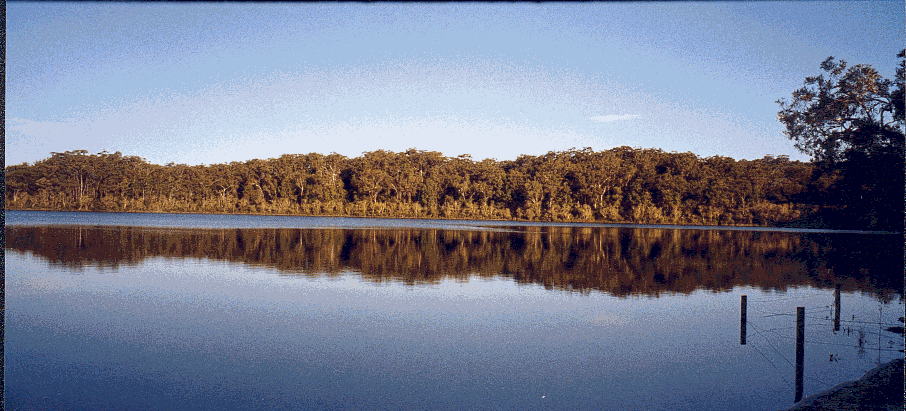There was an official reason for our visit. SCICADE, an international scientific
grouping with a special interest in the somewhat exotic subject of differential equations
and their application to system simulation, had decided that the Kingfisher Resort looked
a likely site for their next meeting. Fraser Island had not been all that high on our wish
list, but this was certainly a convenient excuse, and we had enjoyed some splendid photos
of the trees taken by Dave Mitchell. Inskip Point at the northern end of the Cooloolah
National Park is the start point for the shortest (and cheapest) ferry crossing. The
loading is on demand (no booking required) and a turnaround time of about 30 minutes would
be a reasonably good guide. There is a National Park Ranger Station at Rainbow Beach where
tide times, park fees and camping permits can be obtained. There do not seem to be any
particular access restrictions in force with `first in best dressed’ being the rule
currently in operation.
We timed things nicely, driving up from the Gold Coast in fine weather just in time for
low tide at about 11.00 am. The 20 minutes barge trip provided an opportunity to adjust
tyre pressures. We then had a pleasant run along Seventy Five mile beach on firm sand as
far as the Eurong Resort. Benching at the occasional creek crossing provided the only
occasions for caution – a Japanese group flipped on one of these a few days later.
Here we left the beach using the track to the main Ranger Station at Central Station with
the aim of lunch at Lake McKenzie. This took us into the area of the major forests which
really are something special.
Getting them out would have been straightforward if there had only been a towing point
on the vehicle. There was a Hayman-Reece towbar, but no locking pin. Fortunately these
seem to be generic. The driver was quick to reduce tire pressure after this lesson. We
only had time to explore around the lake and associated walking trail before dusk which
came in with some rain.
Tuesday was fine and warm. That this was noteworthy is an indication of the kind of
winter Queensland has been having. Technical commitments did not seem too attractive after
lunch so we decided to explore. Our route went from the resort to Lake Waby, then down the
beach to the Lakes Way, and so back to Lake McKenzie. Although we had most of the
afternoon, this proved quite a severe itinerary with relatively little time for exploring
– the inland tracks are not fast.
Wednesday was the day of the conference excursion. The tide was just ideal for a long
run up the beach. We got as far as Indian Head within our time constraints. There is what
should be an ideal campsite here sheltered from the south and east by the Head. However,
it looked like tent city. Also, neighbours at Lake McKenzie told us that many of the
Indian Head campers were long stay, and that motor driven compressors were a definite
sleep hazard. Evening storms - some of the campers around us got very wet.
On Thursday, conference constraints meant we were able to do little more than explore
Central Station and the surrounding forests. Return constraints on Friday meant we had to
leave relatively early and head for Hook Point by the slow inland route to avoid high
tide. This uses the Lake Way to Dili Village and then a route behind the dunes that would
once have been sealed but is now being allowed to deteriorate. There was some excitement
on the beach waiting for the ferry. A Discovery just made it, losing drive just as it
reached the sand. The driver was getting some traction by pulling on his handbrake but
otherwise…. He had to be towed on and off the ferry. Turns out that he most likely
had a broken rear drive shaft, and that progress could be made in front wheel drive by
locking the diff. There had been warning sounds as he had been driving down from North
Queensland, but a couple of Land Rover service operations had been less than helpful. Our
return trip was uneventful. We managed to miss the worst of the traffic on what had been
the Gold Coast Highway and may become a super expressway. Right now it is an exercise in
patience.
There is a lot of hype about Fraser Island. We both felt our curiousity had been
satisfied. For us the best feature is the forest with the unique Satinay trees which are
quite splendid. The worst effects of the tourist load that registered was the widening of
the inland tracks as a result of people improvising passing lanes instead of using those
provided. The biggest disappointment has been our inability to get good colour fidelity in
scanning our beach photos.
Mike and Gloria Osborne.


